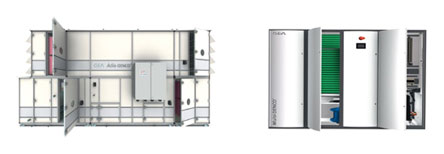Air Conditioning Equipment Specialists
GEA DencoGEA Multi-DENCO®: precision climate-control units for constant temperature and relative humidity
The GEA Multi-DENCO® range of precision climate-control units will replace the old Denco T and E ranges. Multi-DENCO® will be available in various model sizes, from 5 kW up to a maximum of 130 kW cooling duty. These units operate with refrigerant R410A and, under typical conditions, operate with a sensible heat ratio (SHR) of 1. This means that Multi-DENCO® units can cool the air without at the same time dehumidifying it. In recirculating-air mode the units control air conditions at a stable level of ± 1 K temperature and ± 5 % relative humidity. The possibilities of employing the units extend from computer centres and machine rooms with intensive production of heat, to measuring laboratories and art museums – for which not only a standard temperature but also constant relative humidity are critical.The enhanced energy efficiency in GEA Multi-DENCO® precision climate-control units is achieved first by an optimised configuration of heat exchangers and fans as primary components – for which firstly the circulating air encounters less air resistance in the unit. Secondly, the heat exchanger has greater dimensions. The resulting large air volume leads to greater stability of temperature control. The inverter drive, which controls the refrigeration compressor variably and steplessly, adapts the unit output to the cooling demand – which results in high energy efficiency, especially in partial-load operation. The units from the GEA Multi-DENCO® range are equipped with EC fans that feature very low power consumption. Since the units operate especially energy-efficiently under partial load, they are ideally suited as standby redundant systems.
The Multi-DENCO® range, all models of which are otherwise identical, offers five different cooling systems. The range will be launched in winter 2012/2013 with the A Version, which operates with an air-cooled condenser. The C Version will be chilled water-cooled, and the X Version will be equipped with a direct expansion evaporator that can be linked to an external air Cooled Condensing Unit. All three versions can be retrofitted with an additional chilled water heat exchanger to provide the CombiCool version. The water-cooled W Version can be expanded to a F Version by adding a free-cooling function. These Multi-DENCO® versions will be introduced to the market, one after the other, beginning in 2013.
The Multi-DENCO® precision climate-control units will be available in various model sizes for a range of different room concepts. For all versions, the units have a height of just under 2.0 m, and the footprint will range from 60 x 60 to 88 x 338 cm, depending on the model.
An overview of GEA Multi-DENCO® climate-control unit versions
A Version operates without water, but with a refrigerant cycle. As a result of its comparatively low installation and investment costs, it is particularly suited for data and server rooms.C Version, with chilled water cooling and without a compressor, has been designed for medium-sized and large computer centres and for installations with long pipe lengths.
X Version features an external air-cooled condenser unit. It is most suitable for use in populated rooms where noise levels are important: for example, in measuring labs.
A, X, and C Versions can be upgraded by adding a chilled-water cooling coil to form a CombiCool system. The benefit of the CombiCool version is redundancy with a small footprint. In addition, the second chilled-water cooling coil can also be used as a secondary free-cooling coil to save energy and for use under peak-load conditions.
The water-cooled W Version with compressor is especially effective for machine and server rooms, small- to medium-sized computer centres, and installations with long piping – because all DENCO precision climate-control units can be connected to a single circuit of pipework.
F Version (AmbiCool), with free cooling, offers a second heat exchanger in addition to a refrigerant cycle. It is especially intended for applications in which operating costs play a key role. Combined operation – i.e., free cooling plus compressor based cooling – becomes possible as soon as the water or a glycol-water mixture is provided at 1 K below the required temperature. When outdoor temperatures are low, compressor operation is often unnecessary – with a corresponding reduction in compressor operating time.

FlaktGroup Ltd
Unit 1 Ashville Way
Ashville Industrial Estate
Runcorn
WA7 3EZ
Ashville Industrial Estate
Runcorn
WA7 3EZ
 UK
UK Ireland
Ireland Scotland
Scotland London
London










